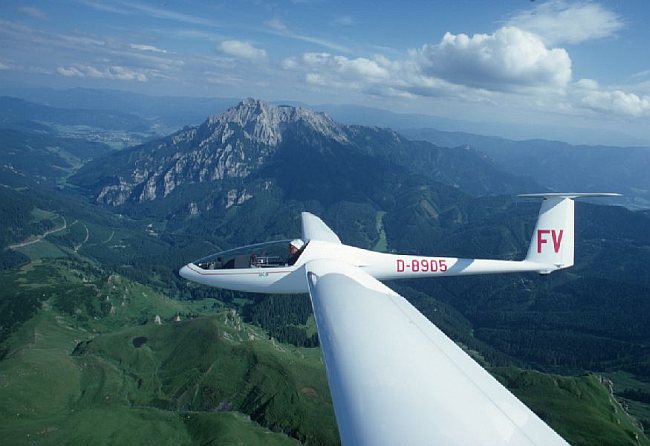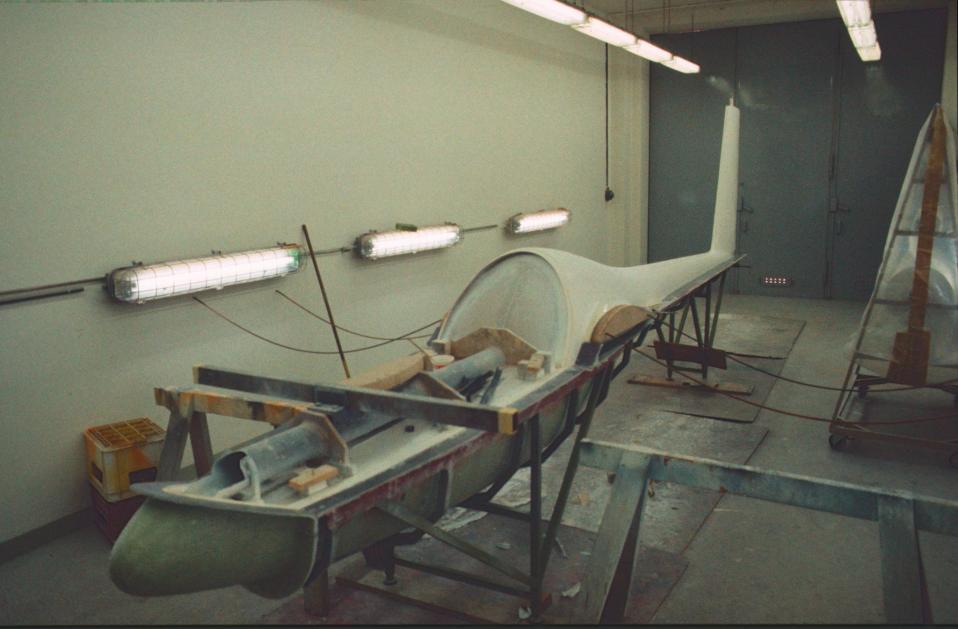AK-5
The AK-5 is our first aircraft that we built from fiber composites. It is still widely used today as a training aircraft.
Development: 1984 -1990
Start of Construction: 1985
Maiden Flight: 01.06.1990


The AK-5 was born out of the group’s desire to design and build a simple glider. The AK-5 was to complement the Akaflieg Karlsruhe aircraft fleet as an up-to-date, contemporary glider. The main objectives were for the group to gain experience in building modern gliders in fiber composite construction, to create good documentation for subsequent glider projects and, last but not least, to strengthen the group’s team spirit and create a sense of responsibility.
As the AK-5 was mainly about gaining experience, many parts were taken from production gliders. The wing was based on that of the Falcon prototype by Streifeneder, whereby the molds could also be used. The initial plan was to adopt the wing geometry and modify the upper side of the airfoil. However, after tests in the wind tunnel, in which no significant improvement could be determined by modifying the airfoil, it was decided not to modify the airfoil. The fuselage is based on the Glasflügel 604, but has been shortened. Many components of the control system and the wing and tailplane connections were also adopted from Glasflügel. The cockpit design focused in particular on ergonomics and the canopy emergency release mechanism. Thanks to this conceptual design, it should be possible to have a ready-to-fly glider available in the near future. Shortly after the start of the project in July 1984, the ambitious goal of the first flight in 1985 was announced.
The mold construction turned out to be very complex. For this reason, however, it was directly planned to build more than one sample. The negative mold of the glass wing 604 could be used to make a positive fuselage mold and then the negative fuselage mold. The wing molds of the Falcon had to be completely refurbished, as they had been stored outdoors for a long time and had become completely warped as a result.


Over time, the members gained more and more insight into glider construction and the associated requirements. One requirement was to break the wing. For this reason, a breakage wing was initially built in 1986 and a breakage test was carried out. It was also necessary to produce an introductory wing, as the connection of the wings and the connection to the fuselage were also to be tested. Once the break test had been successfully completed, it was finally time to build the flying wing. The construction of the fuselage continued apace.
After construction progressed rapidly in the following years and not only the larger parts were manufactured, but also the tailplane, built-in parts, canopy, controls, etc., the aircraft was finally ready in 1989 for the static oscillation test to be carried out. After the flutter calculation based on this was also completed, nothing stood in the way of the first flight. After the final minor work, the first flight took place on June 1, 1990.
Flight testing began immediately afterwards, whereby the general flight behavior, the stall and slow flight characteristics and the static stability were investigated. The spin test was also carried out directly in 1990. The AK-5 was also measured at the Idaflieg summer meeting. Due to the many satisfactory results of the flight tests, the AK-5 was already made available to a larger circle of pilots at the end of the year so that wide-area testing could begin.
On June 11, 1994, Professor Felsch christened the AK-5 “Ardea”. This was in the tradition of the Akaflieg, in which the aircraft were given Greek names. “Ardea” means ‘heron’.
In 2001, a project was launched to optimize the AK-5. This included the activation of a blow-out system and the construction of attachable winglets. With the help of paint schemes, the optimum position of the exhaust was determined and finally fitted. After comparative flights with the clip-on winglets compared to the AK-5b, it was decided not to attach these winglets permanently, as the effect was too small. The winglet project on the AK-5 was later abandoned.
After the AK-5 had become a permanent fixture in the Akaflieg Karlsruhe fleet over the years and could also be used for training, the final individual certification was still missing. After further processing of missing certificates and successful re-flight inspections by the Federal Aviation Office, the single-unit certification was finally achieved in 2018. As a result, the AK-5 is now a fully-fledged glider that is integrated into the aircraft fleet and used for training and performance flying.
